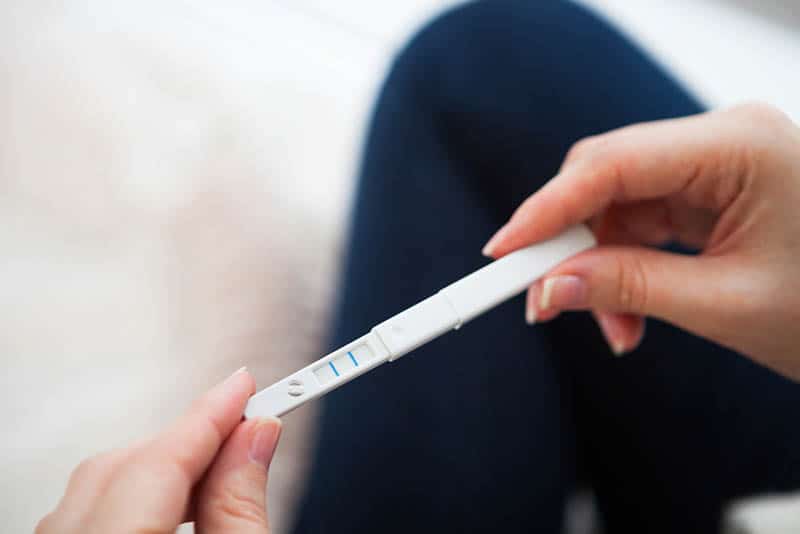Pregnancy test results are precise most of the time, but you might occasionally end up with a false negative or a false positive pregnancy test.
False negative and false positive pregnancy tests happen from time to time, usually due to the misreading of home pregnancy test instructions, a recent miscarriage or certain medications.
There are plenty of other reasons, but most of them boil down to either user error or the misreading of hCG levels in urine.
HCG is a hormone better known as human chorionic gonadotropin, and it’s one of the many hormones that are produced during early pregnancy .
At-home pregnancy tests are designed to detect the presence of these hormones when placed in the urine stream.
When the amount of hCG is sufficient, the test should show a colored line that indicates you’re pregnant.
This is how most home pregnancy tests work, and are especially useful during early pregnancy if going to the doctor for confirmation isn’t a viable option.
However, they are prone to showing a false positive on occasion.
While this can be a disheartening prospect, it’s not the end of the world and it doesn’t mean that you’re unable to conceive.
Most incidents of false positives are rare and one-offs. It’s very uncommon for them to be recurring events, but it’s important to be aware of the fact that they can happen, so it doesn’t come as too much of a shock when it does.
So, what are some of the most common things that register a false positive pregnancy test result?
8 False Positive Pregnancy Test Possibilities
1. Not doing the test properly

Let’s begin with a mild case of user error. We’ve all been guilty of throwing the instruction manual aside, thinking we already know what we’re doing, only for it to bite us later.
This is a common case in this instance.
At-home urine pregnancy tests are very sensitive, and must be done precisely for them to show accurate results.
If not, you’re likely to get a false positive or even a false negative pregnancy test.
While this could happen regardless, because the tests aren’t foolproof and you may be using one that’s gone past its expiration date, the most common reason is people not following the instructions to the letter.
Again, it’s a very common thing to happen the first time you try and use an at-home pregnancy test. Lord knows I’ve messed up a few times myself, due to anxiety and my own impatience.
The proper way to go about it is to do the test first thing in the morning, because that’s when your urine is at its most concentrated.
The mistake that most women make here is using any urine sample, which may end up giving a negative result, or rather a false negative pregnancy test result on occasion, because they have done it with water-diluted urine.
Some women try taking the test on the first day after trying to conceive.
This doesn’t leave the body enough time to produce hCG in sufficient amounts to register on a pregnancy test, which will also lead to a false negative.
Another common mistake that leads to a false positive pregnancy test comes from misjudging the time the test is meant to be kept under the urine stream.
If held under the urine stream for too long, the test can yield a false positive result the same way it can lead to a negative one.
Read what it says on the box of the test very carefully and ensure that you follow what it says to the letter. Small variations are allowed, but some sort of timer is always recommended.
It’s very important to follow this step if you want to correctly measure the levels of hCG in your urine.
Plus, it’s not worth giving yourself a false sense of hope by keeping the dipstick under the stream for longer than necessary. It won’t change the actual result, and will only serve to set you up for disappointment when it turns out to be incorrect.
Following up on this, it’s also important to note how long you need to wait for the result to appear.
Don’t rush. I know that the wait can be agonizing and stressful, but it’s best to be patient so you are sure of the correct result.
2. Evaporation lines

A unique factor in the case of at-home pregnancy tests are evaporation lines.
These are colorless representations of a second line that might make you think you’ve achieved an early pregnancy, but in reality are nothing more than a false positive pregnancy test result.
They normally appear in place of the second line, which represents the presence of the hormone hCG, with either a blue or some shade of pink depending on the test.
The colorless lines appear in place of a second line after the urine contained in the test completely evaporates, if the cause behind the hormonal detection wasn’t hCG but a completely different hormone altogether.
The reason why they appear is linked to the first example of not following the instructions properly and not sticking to the right time frame in which the test remains valid.
3. A chemical pregnancy

This is also basically harmless, but can be impactful on your state of mind if you find out it was the reason for a false positive pregnancy test result.
This is because chemical pregnancies are quite common. It’s what happens when the fertilized embryo either doesn’t grow, achieve implantation or manage to travel down the Fallopian tubes.
The initial trigger might raise hCG levels up high enough to indicate a valid pregnancy, but it’ll eventually turn out to be negative, which will come as a great shock to any woman who is trying to get pregnant with her future child.
This is what’s referred to as early pregnancy loss, and usually occurs when a woman tests herself for pregnancy during the first week after attempted conception and her first missed period.
It’s important to remember that you’ve done nothing wrong because this is another common occurrence that generally goes undetected if the appropriate amount of time is waited before taking a pregnancy test.
The reasons can vary, but usually boil down to these:
• Low levels of the pregnancy hormone progesterone.
• An irregularly-shaped uterus.
• Fibroids/scar tissue in the uterus itself, from surgeries or other complications.
There are others, but they are currently unknown.
To reduce the chances of an incorrect result, the best thing you can do is stay calm and to do the test within the correct time frame. This will help lessen the emotional impact.
4. A tubal/ectopic pregnancy

Moving on to some of the more serious causes, we have ectopic pregnancy.
This is a condition where the fertilized egg attaches, or rather gets stuck inside, the Fallopian tubes and implants itself there.
This can also happen in the abdominal cavity, your ovaries or even your cervix.
While it’ll still register as a normal pregnancy, as the egg is technically fertilized and growing, it’s doing so in the wrong place, which can become severely detrimental to your health if left unchecked.
You’re likely to experience blood loss that gets progressively more severe or, in the worst case scenario, could even have to undergo a hysterectomy; a surgical procedure where the uterus is removed in order to save your life.
This is why it’s important to spot an ectopic pregnancy early on.
These are the symptoms you should be on the lookout for:
• Bleeding from the vagina.
• Nausea.
• Increasing pain in the side of the abdomen, shoulders, neck or pelvis.
• Fainting.
• Rectal pressure.
• Dizziness.
Ectopic pregnancy is a serious problem that threatens pregnant women’s health, and their future, if it is not detected early, which is why it’s important to always be on the lookout when trying to conceive.
Should you spot any of these symptoms, be sure to seek medical help from your doctor, obstetrician/gynecologist (ob-gyn) or any other certified health care professional as soon as possible.
5. A molar pregnancy

A rather gruesome cause could be a molar pregnancy.
This is what happens when a sperm begins splitting prematurely during the fertilization process, or when there’s no fetus in the placenta but it keeps growing regardless.
Due to this growth the body still views it as a normal pregnancy, and will produce hCG hormones that will register a false positive pregnancy test result.
Thankfully this is a very rare occurrence, that only happens in 0.1% of all cases, so you should be safe in that regard, but do bear it in mind as a potential cause.
It shouldn’t cause you any problems if you regularly check your pregnancy with the doctor, as the mass growing inside your uterus will be spotted by a routine ultrasound checkup, and removed as soon as it is.
Either that, or you’ll end up having an early miscarriage due to an unviable fetus being present in the womb, the realization of which will be crushing to any hopeful mamma.
6. Medication

Certain types of medication can trigger a false positive pregnancy test result if you were to take one shortly after taking them.
The most common culprits in this case tend to be fertility drugs alongside other fertility treatments.
That’s because they’re treated as synthetically produced doses of hCG, which trigger the release of mature eggs and, despite being artificial, will still activate the second line on the pregnancy tests.
The most common fertility drugs that qualify for this are:
• Profasi.
• Ovidrel.
• Novarel.
• Pregnyl.
So, if you are currently taking any of these, be sure to listen to the medical advice your doctor gives you, and be patient when using a pregnancy test, otherwise you might potentially be disappointed.
However, there are some other meds that don’t fall into this category, which can also cause a false positive pregnancy test result. These are:
• Antihistamines.
• Antipsychotics.
• Anti-anxiety meds.
• Diuretics.
• Methadone.
• Meds for treating Parkinson’s.
As well as a number of others, so do be wary of your test results if you find any medication you might currently be taking on this list.
7. Medical conditions

There are several underlying medical conditions which can cause a false negative or false positive pregnancy test result to occur, as well as actual medication itself.
Some of these are:
• Problems with your pituitary gland.
• Some forms of kidney disease.
• Urinary tract infections (UTIs).
• Ovarian cysts.
• Ovarian cancer.
There are a number of others, but the field is still being explored.
Although, if you are unfortunate enough to suffer from one of these conditions, they might well be the root cause of the appearance of the incorrect results.
8. Having an abortion or an early miscarriage

Finally, one of the most devastating reasons for incorrect results is when trying to conceive shortly after having made the difficult choice to have an abortion, or when you’ve had to suffer through the gut-wrenching pain of a miscarriage early on in your pregnancy.
While these are awful enough things to happen by themselves, it’s the sliver of hope that a false positive pregnancy test result provides that adds the final devastating blow.
This happens if either event occurs during the first half your first trimester, the hCG hormone will then still be present in the body and will register in the urine at this early stage.
This is because the placenta continues growing, which causes the body to think it is in pregnancy mode. Once it stops growing, the levels will slowly start to reduce, but it’ll take around 5-7 weeks to get completely back to normal.
On rare occasions pregnancy tissue can still be present in the uterus, which contributes to elevated levels of hCG in your urine.
How Often Do False Positive Pregnancy Tests Occur?
They’re quite rare, with the average rate of an incorrect result being around 1%, although that number can vary based on the reasons discussed above.
What Should You Do After You Get A Positive Pregnancy Test Result?

The most important thing is to remain calm. Then you should schedule an appointment with your doctor to confirm that you are definitely pregnant, and it’s not a false positive.
This is done via a urine and blood test conducted by the doctor himself, a more accurate pregnancy test that allows him to check if there was definitely a fertilization or not.
The doctor is also likely to perform an ultrasound so he can confirm whether or not it has resulted in a legitimate pregnancy.
If it does end up being a false positive try and remain calm, because stress can be a negative factor when trying to conceive.
Try and prepare yourself for the worst every time, so you at least lessen the impact for the next time you try. It’ll take a long time before it’s too late.
Regardless, there are still a few factors that you should take into consideration in case this has been going on for a while, age for example.
If you happen to be over 35 and are still unable to conceive, the issue might be infertility.
If this is the case, I suggest seeking medical advice from a professional on the matter, to help you maximize your chances of conception.
As I mentioned previously, stress is a big factor in this as well. It rules over every aspect of our bodies, including the reproductive organs, so it is advisable to reduce stress levels as much as you possibly can.
For stress reduction, I’d recommend seeking professional help and surrounding yourself with like-minded and supportive people. It’ll help melt a lot of those worries away.
In Conclusion
A false positive pregnancy test result can be a mentally exhausting experience for any mother to go through.
While somewhat uncommon, the possibility of it still looms, and it can happen to anyone for a variety of reasons.
The causes can range from serious issues like scar tissue on your reproductive organs, ovarian cysts and an ectopic pregnancy, to less obvious causes like seemingly unrelated medical conditions, medications or even simply not following the instructions on the pregnancy test.
The important thing is to never lose hope, regardless of whether it’s a false alarm or not, and to keep trying, because the next time it might not be!
All I can really recommend is to follow the instructions of your at-home pregnancy tests carefully, and check every positive test result with your healthcare provider to confirm the pregnancy.
Sooner or later, you’ll get the green light from the doctor and you can begin the wonderful journey of pregnancy and taking care of the little one that’s growing inside your belly.
READ NEXT: Symptoms, Causes, And Risks Of Cryptic Pregnancy
Like this post? Please share or pin it for later. You can also stay in the loop and follow us on Facebook, Instagram or Pinterest.

This post contains affiliate links. Please see our full disclosure for more info.

